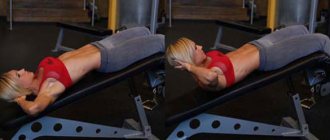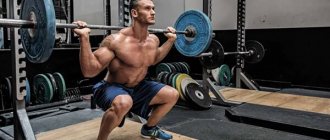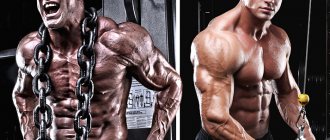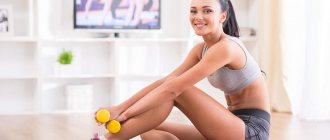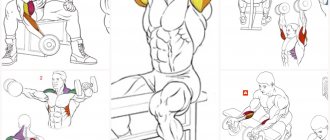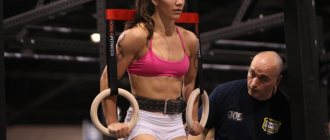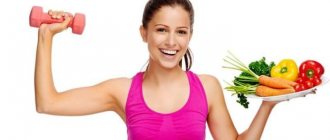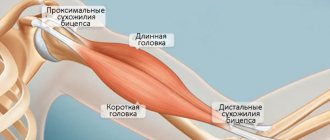How to treat the core muscles
Many people believe that the abdominal muscles are the core. But this is a much larger group, consisting of as many as 29 couples!!! Let's see where they are.
Abdominal muscles
- Direct (Rectus abdominis) - located inside the abdominal cavity; those same “six packs”; Allows you to bend your torso.
- External obliques are concentrated on the sides of the body and extend from the lower half of the ribs to the pelvis; allows you to rotate your torso.
- Internal obliques are muscles that allow you to rotate the torso and provide stability to the spine.
- Transverse (Transversus abdominis) is one of the deepest abdominal muscles; the main function is to stabilize the lower back and pelvis before movement of the arms or legs occurs
- The quadratus lumborum muscle is the deepest abdominal muscle and is commonly referred to as the back muscle; stabilizes the movement of the spine and pelvis.
Back muscles
- The erector spine is a bundle of muscles and tendons located along the spine; needed to keep your back straight and allow your torso to rotate from side to side;
- Multifidus is a deep postural muscle located along the spine; plays an important role in stabilizing the vertebrae in the back;
- The semiaxial (Semispinalis) is located at the back and is very long; responsible for maintaining posture and movement of the head and spine;
- The latissimus dorsi muscle is one of the largest in the back; rotation and hand movements work;
- Iliopsoas - refers to the internal muscles of the thigh; Allows you to rotate your pelvis, flex at your hips, and stabilize your body when you stand.
- The pelvic floor muscles (Pelvic floor) are a group of muscles that envelop the pelvic bones from the front and back; hold the organs and structures of the lower abdomen in place and thus affect urology and sexual function.
Gluteal
- The gluteus maximus (Gluteus maximus) is considered one of the strongest in the human body; Helps you get up from a sitting position, climb stairs and stay upright.
- The gluteus medius (Gluteus medius) is located above the gluteus minimus and below the gluteus maximus; keeps the pelvis in a neutral position while walking and running.
- The gluteus minimus (Gluteus minimus) is located directly under the gluteus medius muscle; One of the main functions is raising the legs.
Advantages of classes on Core
“Exercises on this apparatus work out not only the muscles it is aimed at, but also those that help keep the body in the desired position without falling. In an effort to maintain balance, deep stabilizer muscles are pumped: the latissimus dorsi, oblique and transverse abdominal muscles, muscles of the hips and buttocks, and pectoral muscles. — For 1 lesson, you spend from 300 to 400 kcal. This is intense training; maintaining balance requires a lot of energy. — The load is two in one: strength and aerobic at the same time. — Develops a sense of balance and improves coordination of movements. — The skill of correct posture is formed. — Training is a prevention of osteochondrosis and the development of intervertebral hernias, since all the muscles that support the spine and back are strengthened. — The core platform is safe, durable and easy to use. It will not take up much space in your home, but will bring great benefits.
Formative muscles and functions
The word “core” came into Russian from English (core), and is translated as center, core. It transfers force between the upper and lower body. The core is not only the abs, but also the area around the spine, in the groin. This group includes the following muscles:
- abdomen - oblique, transverse, straight;
- buttocks - small and medium;
- back of the thigh;
- infraspinatus;
- coracobrachial;
- leading.
The condition of these muscles depends on:
- presence and size of the abdomen;
- posture;
- chest shape;
- spine and hip health;
- the functioning of various body systems - genitourinary, especially in women, digestive, excretory;
- strength - body, explosive;
- ability to maintain balance;
- movement speed;
- correct position of internal organs.
What types of core training are there?
Core training is used in many ways: activating muscles and correcting dysfunctions, improving various types of stabilization and/or developing muscle strength, power and endurance. The following sections expand on these topics.
Activation and correction exercises
When training strength, trainers often include low-intensity “activation” loads in the warm-up or between sets of multi-joint exercises as corrective or “prehabilitation” exercises (that is, to prevent injury). While corrective exercises restore fundamental movement patterns by increasing joint mobility and stability and movement control, prehabilitation exercises allow muscles that are normally inactive to maintain arousal. Although corrective exercises are proactive, while prehabilitation exercises are preventative, the exercises and training used in both methodologies are similar. Using these movements at the beginning of a training session as a dynamic warm-up provides several benefits: they warm up the muscles and joints, prepare them for full-range movements, activate the nervous system and correct or prevent possible dysfunction. Activation load can be used during rest between exercises to increase the motor density of the activity, as well as for the productive use of “downtime”. Bird dogs and x-band walks are two examples of “prehabilitation” exercises that can activate the core muscles and maintain their ability to engage in functional movement, preventing overcompensation of synergistic muscles.
Activation work prior to explosive movements has previously been shown to increase strength and power. Thus, performing seven exercises that activated the gluteal muscles, including glute bridges and side-lying clams, led to an 8% increase in peak power in the squat jump (3). Moreover, in a study by Wagner et al. Activation exercises have been shown to increase hip extensor strength concurrently with a decrease in hamstring activation during the swing and first half of the stance phase in triathletes suffering from transient hamstring cramps (18). Activation work should be performed with low loads at lower neuromuscular thresholds, with emphasis on correct form.
Stability
Core stability training involves performing exercises aimed at improving the stability of the entire body, the spine, or individual segments (11). Since the core is described as “proximal stability for distal mobility,” a weak and unstable “core” can be associated with the problem of disruption of kinetic chains (6). Stabilization core training includes functional balance training along with traditional stabilization core exercises.
Sensorimotor and balance training are sometimes included in athletes' training programs to improve proprioception and coordination. Several studies have found that sensorimotor training can have a positive effect on power production (9). Exercises on unstable surfaces using BOSU balls, inflatable discs and wobble boards are usually included in this category. It should be noted that balance training does not require special equipment, other than performing single-limb exercises (single-leg Romanian deadlifts, pistol squats, or step-ups with knee raises), which effectively stimulate the sensorimotor system with a load appropriate to that used for sports activity. Therefore, trainers need to include combinations of unilateral and bilateral exercises in their strength training programs.
Although dynamic contractions are necessary to stabilize spinal segments, traditional stabilization exercises require isometric contraction of the core musculature to prevent flexion of the lumbar spine and pelvis, allowing efficient transfer of energy throughout the body. Most often, two types of exercises are used for core stability: isometric for the whole body and isometric core contractions during dynamic movements of the limbs. An example of the first type of exercise is the “plank”, where the position of the entire body is fixed. The 3-point plank is the second type of exercise, where the core remains stable while the limbs move through full range of motion. Many sports require rapid and strong isometric contractions of the core musculature, which appears to require a combination of training methods.
Force
Dynamic and static exercises can be used to increase core strength. Stabilization exercises that help increase isometric strength were described in the previous section. In this case, dynamic exercises involving concentric and eccentric muscle contractions will be discussed. Many sports movements require relatively slow but powerful core movements, for example, when the strongest powerlifters perform a deadlift, dynamic back flexion occurs; in mixed martial arts, many situations (clinching or floor wrestling) require lumbar flexion (10). Dynamic core exercises are preferable to isometric exercises for increasing muscle mass (5).
Power
Many athletic movements require powerful dynamic contractions of the core muscles. This manifests itself in a rapid increase in stiffness to transfer kinetic energy between the upper and lower body. For example, most throws, swings, and hits involve multiple levels of hip and spine rotation; even sprinting requires high levels of core muscle contraction to produce, reduce, or transmit force. Varying training methods and contraction rates with core stabilizing exercises, as well as intense resistance training, can help achieve maximum core power.
Endurance
Core endurance is an integral component of many sports and athletic movements such as rowing, boxing, rugby, etc. Performing a high number of sets and repetitions appears to be necessary in this case to increase core endurance. It is likely that core endurance is more important than strength to prevent low back pain (12).
Is it worth buying a membership for core muscle training? And what to expect from such classes?
Specialized classes and workouts can be found at most gyms. They are diverse in their focus and goals. The benefit of such exercises is that you can learn more about your body, its internal muscles, and also further diversify your own training plan with new exercises.
Whether or not to buy a subscription to such classes is, of course, up to you. You can arrange your own workouts at home. But if you notice that you often don’t finish what you start, stop working out if something doesn’t work out, or you’re not sure about the correctness of doing this or that exercise, it’s still better to go see a professional for another month. The instructor will monitor the technique of performing the exercise, adjust as necessary and motivate you to move on.
How to Strengthen Your Core Muscles 4 Effective Planks
Plank
Kristina Podrezova
Take a lying position, extend your arms under your shoulders (the body should form a straight line from the shoulder girdle to the legs).
The legs should be straight, without bending at the knees, the pelvis should be twisted (not tending upward), the abdominal muscles should be tense and, if possible, pulled towards the ribs.
The lumbar region should be flat, and the legs should be placed together to increase the load on the abdominal muscles. Lock in this position for 40 seconds.
Plank with rolls
Rotate your hips first in one direction, then in the other. When turning to the side, you can lightly touch the floor with your hips.
Do 20 repetitions (both right and left turns are counted at one time).
Plank with arm raise
Take a classic plank position with your arms straight. Feet are the width of the mat. The abdominal muscles are tense.
Raise your hands one by one and touch your shoulder.
Do 20 repetitions (one repetition is raising the right and left arms).
Dynamic bar
Assume a regular plank position with your arms straight. The back should not bend. Don't lower your pelvis too low.
Important!
First, bend your right arm and lower yourself onto your elbow. Then bend your left arm. Raise your right and left arms in sequence. Lower yourself to your elbows again.
Do 20 times.
We thank the Boxing Brothers Club for their help in organizing the filming. Related articles Downloading your abs: 5 coolest types of planks What will happen if you do a plank every day 20 ways to do a plank 10 types of planks you had no idea about
The post “How to strengthen your core muscles: 4 effective types of planks” first appeared on The-Challenger.ru.
Exercises on a balancing platform
Squats
- Place one foot on the edge of the platform, and carefully place the other on the other edge and find your balance. Place your feet parallel to each other.
- Tighten your abdominal muscles and slowly squat, moving your pelvis back until it is parallel to the floor. The knees should not form an acute angle.
- As you exhale, slowly rise up, maintaining your balance at all times.
Lunges
- Place your supporting foot on the center of the platform, and the other on your toe back on the floor.
- Slowly lower your pelvis and knee of your back leg without pushing the knee of your supporting leg forward.
- Then slowly rise up, maintaining balance.
- Perform a set on one side, then switch legs.
Gluteal Bridge
- Lie on your back with your knees bent, feet on either side of the platform and balance.
- Exhale and lift your pelvis up, squeezing your buttocks and maintaining your balance.
- As you inhale, slowly lower your pelvis to the floor.
Push ups
- Place your palms along the edges of the platform. To ease the load, you can place your knees on the floor. If your physical fitness allows, do push-ups on straight legs.
- As you inhale, bend your elbows, lowering your chest toward the platform. The closer the elbows are to the body, the greater the load on the triceps.
- Exhale as you straighten your elbows.
Plank
- The exercise is performed statically, both on the elbows and straight arms. Choose an option depending on your own capabilities.
- Maintain a straight torso position, squeezing your core muscles to maintain balance.
- Stand in the plank for 30-60 seconds.
- To make it more complex and involve more muscles, tilt the platform using your palms forward and back, also to the left and right.
Side plank
- The exercise can also be performed both on the forearm and on the straight arm.
- Place your support hand on the center of the disc, take a side plank, turning your torso to the side. From your feet to your head, keep your body in a straight line, and most importantly, maintain your balance.
- Hold the plank for 30-60 seconds on each side.
- To complicate the technique, you can add pelvic lifts: as you inhale, lower your pelvis to the floor, as you exhale, return it to the starting position.
Best Core Exercises
An exercise is considered effective if it engages multiple muscles and joints (see multi-joint exercises) throughout the torso at the same time, which work together to maintain balance and stability. Some of the best exercises are simple bodyweight exercises. Here is a list of the most basic and effective:
- Dragon flag;
- Plank;
- Side plank;
- Push ups;
- Squats;
- V-shaped rise of the body;
- Gluteal bridge;
- Lifting the hips from a lying position;
- Turning the torso to the sides from a sitting position;
- Plank on fitball;
- Lunge with torso rotation;
- Exercise "Superman".
Benefits of Core Training
Anyone can benefit from these workouts, no matter your level of physical fitness or the purpose of the workouts themselves. As for specific advantages, there are many of them.
A strong core improves performance in the gym, and in all sports, as it produces more energy in the limbs to facilitate the transfer of torque. Simply put, a strong core will allow energy to be transferred from the lower body to the upper body.
When the muscles are weak, all the stress is placed on the spine, which often leads to pain in the hips and/or back. Strengthening muscles takes pressure off the spine and reduces the risk of injuries to the hips, knees and ankles.
Helps burn fat and lose weight
How much weight and/or fat will be burned during exercise will depend entirely on the type of activity. If the plan includes only planks and crunches, it will not be possible to pump up all the necessary groups. On the other hand, if you add a few higher intensity exercises such as mountain climbers, burpees or strength training, it is likely that results will be seen much faster.
If your goal is to lose extra pounds, then the key to achieving results is not just abdominal exercises, but movements that involve the whole body. Performing such exercises in a circuit or interval mode is the best option to achieve your goals.
Tones and builds muscles
Gaining muscle mass will also depend on the type of training. Performing a variety of movements that involve all parts of the body but focus on strengthening the core (squats, deadlifts) is the most effective way to gain muscle mass.
Isometric exercises won't do much to build muscle simply because they target muscles that are needed for endurance rather than strength. To gain muscle mass, you need dynamic strength exercises, first of all.
Core First Workout Stages
- Cardio exercise – accelerates heart contractions and accelerates blood circulation;
- strength load – allows you to “work out” muscle groups;
- stretching and breathing exercises.
The first stage of the training takes place at a dynamic pace. Rhythmic movements, repeated many times, increase the heart rate and saturate the body with oxygen. After such preparation, further loads are more effective.
For the next twenty minutes of the lesson, exercises aimed at strengthening the muscles are performed. Particular attention is paid to “problem” areas.
The session ends with stretching exercises accompanied by calm music. Performing stretching exercises allows you to relieve tension from tired muscles and stabilize breathing.
Core First classes use special exercise equipment, including foam tubing and exercise balls.
This multi-level approach to training allows you to achieve noticeable results very quickly. The excess weight is finally coming off. The silhouette becomes light and sporty. Posture is leveled, muscles gain elasticity and strength. The flexibility of the body increases, the joints become more mobile. In addition to external changes, the heart muscle and lungs are strengthened.
There are no special requirements for equipment. The main rule when choosing sportswear is comfort. T-shirts or T-shirts will do, as well as any sports pants, tights or leggings. Shoes should be sporty and comfortable - sneakers. The most important thing is that nothing restricts movement during exercise.
The article “Choosing the right clothes and shoes for fitness” tells more about choosing sportswear and shoes.
Success stories
Core workouts can do wonders for your body, even though the road to beautiful, lean, sculpted figures can be a long one. We would like to share with you one of the many success stories of a woman and the results of her constant core training (see photo).
“I am a mother of two (ages 2 and 4), wife, farmer, learning and development consultant, and fitness trainer. I wear many different hats and am always on the go!
I have always loved fitness and grew up playing basketball. Training has always been a part of my life. I studied using regular DVDs.
I love to eat! I'm not one of those people who forgets to eat while doing things. It's not about me! I think about food all the time. It took a lot of time and willpower to learn how to eat right. “Proper” meant tasty and good for me, and in reasonable quantities.
Since I do physical work on a ranch, bringing kids with me and a ton of “stuff” for them in bags, I understand how important it is to train my body and build my core. I feel stronger, more confident, can perform any physical activity better without the risk of injury, and also increase strength in other areas of my body
I try to think of food as a source of healthy fuel for my body and eat only healthy foods in the right portions. Strengthening your core and eating healthy is my path to success!”
- https://plankpose.com/core-muscles/
- https://www.verywellfit.com/the-best-exercises-for-core-strength-3120054
- https://fitnessgoals.com/beginners-guide-core-training-tips-advice/
Rate this article:
Didactor
It seems that the ice has broken, dear readers of the Didactor. For a long time, we have been following various domestic educational platforms with their advantages and disadvantages. But each of them offered ready-made solutions, tasks, and content. The teacher was simply a statistician monitoring educational activities. designer of complex interactive educational units has appeared in the Russian educational space .
Core is an online platform for constructing educational materials and testing knowledge with feedback and an electronic journal.
This construction set was created as part of the National Open School . With its help, the teacher can create interactive lessons and interactive worksheets.
That is, we get an effective tool for organizing blended learning.
After creating his account, the teacher gets access to creating an interactive lesson.
You can use templates or start designing a lesson from scratch.
Your lesson tools are on the left side of the panel.
You can insert text, an image, a video, attach a document, enter a test, or organize a survey.
Please note that the organizers of the constructor have introduced several types of control tasks.
The testing tool itself is quite simple:
- multiple choice
- selecting multiple correct answers
Meanwhile, there are other tools for monitoring and formative assessment of students.
Open question . This tool allows you to enter a task with an open answer. For example, a student can write an essay and attach an image.
Classification tool allows you to create a task, thanks to which the student must classify a number of subordinate concepts into categories.
Autocheck issue . You can offer a task where the student must choose one or more versions of extended answers.
Fill in the blanks . You can create an interactive dictation where the student must fill in the missing words or letters.
True, the option with missing letters looks somewhat clumsy, since you cannot reduce the size of the windows.
Exercise . This tool allows you to enter interactive tasks and educational games Learningapps The constructor is integrated with the content of this popular site. You don't even need to copy the html code. Just copy the link and any task will appear on the page you create in full.
After creating an interactive worksheet , the teacher can send it to students.
After receiving the link, students can begin working on the teacher's assignments.
Students do not need to create their own account to work. Just select the No registration . In this case, be sure to ask the guys to enter their first and last name.
The teacher receives operational statistics about the work of students.
It is possible to view the results both for the entire class and for each student individually.
Attention!
After publishing an interactive lesson, further editing is not advisable, because all class data will be automatically deleted.
Check out my little sketch at the link . You can enter a fictitious first and last name. I would be glad if you leave your comments in the interactive task or during the discussion of the article.
Despite all the attractiveness of Core, there are some questions for the creators of the designer.
1 . The platform does not always work reliably . Even with a good Internet connection speed, the platform freezes from time to time, the interactive lesson remains for a long time. And without complete preservation, its publication is impossible.
2. Despite the stated possibility of using videos and images from a computer, I have never been able to download them.
And even with these shortcomings, one can only rejoice at the first experience of Russian developers. By working together, we can help further improve such a successful project.
Some training tips
- Prioritize exercises that require core stabilization, movement on unstable surfaces, and resistance-building strength exercises.
- Do weight-bearing exercises frequently, as every muscle in your core works hard during heavy exercise to stabilize your spine and torso.
- Combine movements of the upper and lower extremities to facilitate torque transmission. Choose from a variety of exercises, from classic yoga poses to push-ups. It will all depend on how intense you want the exercise to be.
- Include static and dynamic exercises in your program so that all muscle groups work during exercise.
- Every workout plan should have at least 4 core exercises.
- Try to do 3-5 sets of each exercise.
- Perform 10 to 20 repetitions of dynamic exercises. Once you can successfully perform three to five sets of 20 reps, add weights.
- It is better to start performing isometric exercises with a 1:1 work-to-rest ratio, 20 seconds each period, gradually increasing the time by 10 seconds to 60 seconds.
What is the core muscle?
Core is the name of the muscular frame that helps our spine maintain its correct shape. But experts still have not agreed on what should be classified as core. Some trainers believe that the frame includes the diaphragm at the top, the deep back and gluteal muscles at the back, the abdominal muscles at the front, and the pelvic and thigh muscles at the hip joints. The last elements are the bottom of the core.
The main muscles that move, support and stabilize the spine are called the core or trunk muscles .
| Torso movements | What movement looks like | Muscles |
| Torso flexion | Forward lean | Rectus abdominis muscle |
| Trunk extension | Standing straight lean back | Erector spinae muscle |
| Torso rotation | Turns left and right | Internal and external obliques |
| Lateral flexion of the torso | Tilt to the side | Obliques, part of the rectus and erector spinae muscles |
| Abdominal compression | Pull in your stomach (bring your navel closer to your spine) | Transverse muscles |
| Spinal stability | Maintains spinal stability during movement | Multifidus muscles |
Other experts insist that the body frame must include the area from the knee joints to the sternum, but particular importance should be given to the muscles of the abdominal wall and back.
No matter how the definition of core sounds, it is clear that the muscles of this complex significantly reduce the load on the spine and help to avoid diseases on its part.
Hemorrhoids kill the patient in 79% of cases
Your core most often works as a stabilizer and force transmitter rather than as a movement initiator. However, people usually focus on their core muscles by training them in isolation. That is, they perform crunches and lateral extensions instead of functional movements such as deadlifts, squats, and push-ups in closed cycles. By training in this way, they forget about one of the main functions of the core, they gain strength more slowly, the movements become less effective, and the health benefits from such training are much less.
Core strength or endurance must be viewed as the ability to produce force, not forgetting the stabilization that controls the force we produce. There are five components of core stability: strength, endurance, flexibility, control and function. Without control and function, the other three components are useless, no matter how strong or resilient you are.
First, core stability must be maintained to protect the spine and surrounding musculature from damage during static and dynamic exercises. Second, you need to learn how to effectively transmit and produce force during dynamic movements while maintaining core stability. This is important both during an Olympic race and when lifting a bag of groceries. Research has shown that athletes with higher core stability have a lower risk of injury. This has been repeatedly confirmed using the Functional Movement Screen (FMS) test. There are many different tests that determine basic stability, but the FMS is the one that is most often recommended because there has been a lot of research done on it and so many effective correction programs have been developed.
